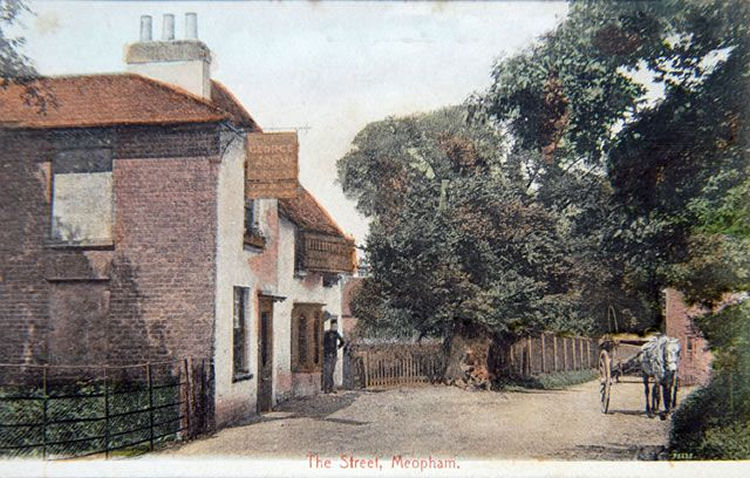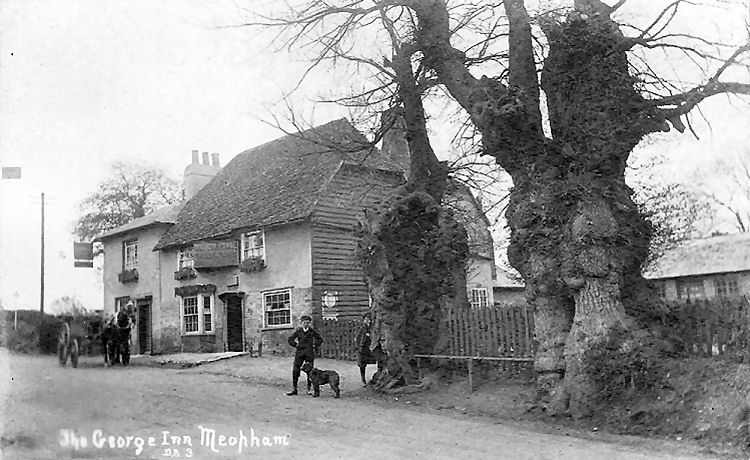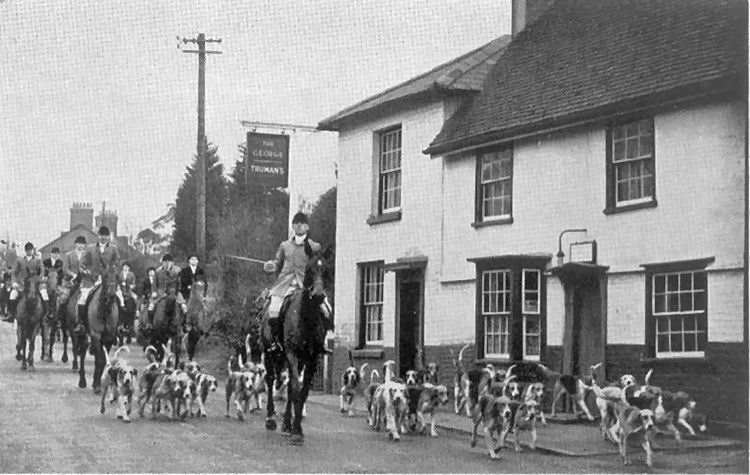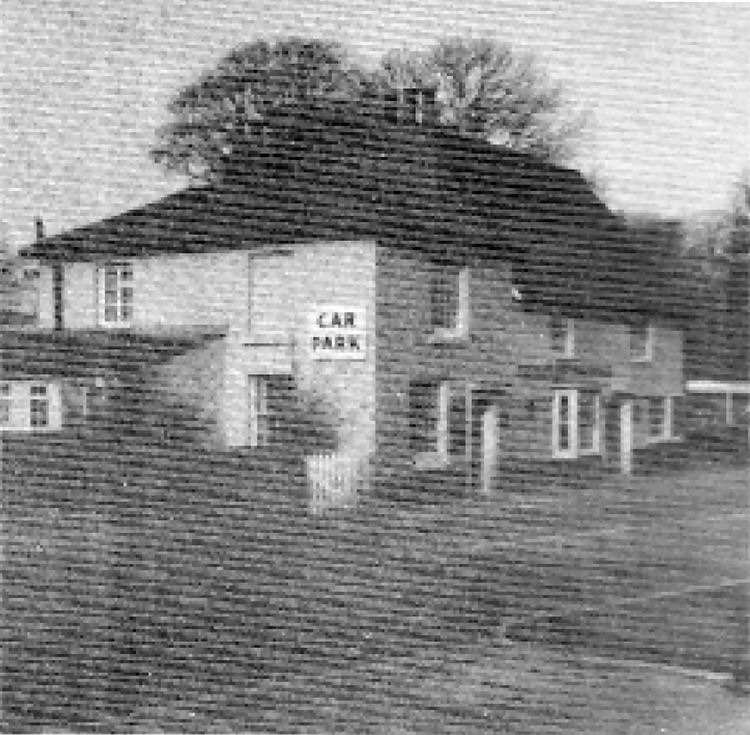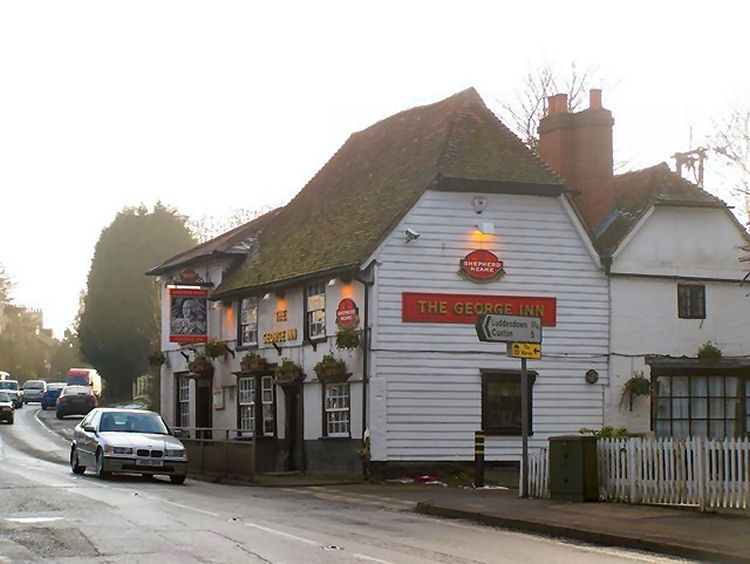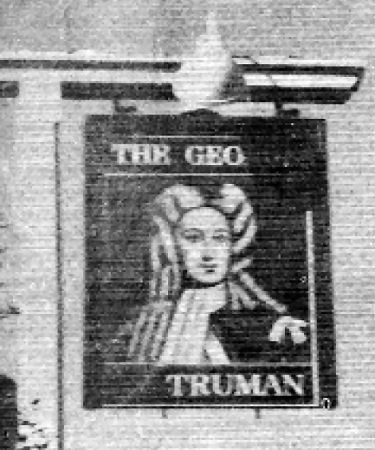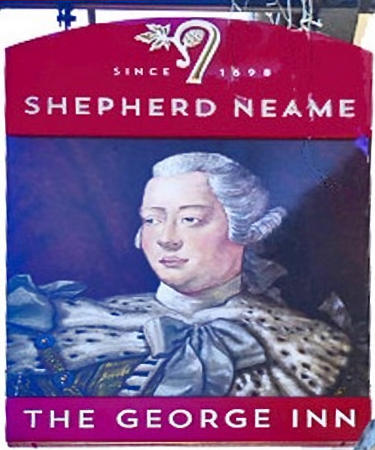Page Updated:- Thursday, 15 May, 2025. |
|||||||||||||||||
| PUB LIST | PUBLIC HOUSES | Paul Skelton | |||||||||||||||
|
Earliest 1663- |
George Inn |
Open 2022+ |
|||||||||||||||
|
Meopham Street Meopham 01474 814198 http://www.thegeorgeinnmeopham.co.uk/
This was the original heart of the village where the church wardens met,
where the first village school was established and the site of the In 1663 the pub was owned by John Child and occupied by Richard Durling. 1757 the Smith-Masters family bought the pub for £300, and put in Thomas Buggs as licensee.
The following has been taken from the 1975 book by Jim Carly, slightly amended to correct innaccuracies. The George, situated at the centre of the oldest part of the village, is almost certainly the oldest of the village Inns. The known history of the village has recently (in 1974) been suddenly projected back to the Iron age by the discovery of an iron age camp in the grounds of the secondary school. This discovery came quickly on the heels of the discovery of 1st century pottery and some ancient ditches just to the south of the George, indicating the existence of a Roman settlement of some sort. There was certainly a settlement here in 788. as evidenced by a charter of King Offa. A will dated about 990 was witnessed by the parish priest. It is therefore reasonable to assume that whenever the need for a inn arose, it would be located at the centre of the village. The earliest known record of the inn is in 1663, when the landlord was Richard Durling, the second licensee was Thomas Boghurst, a name still extant at Boughurst Farm, just beyond the eastern boundary of the parish, but back in 1332, Archbishop Simon de Mepeham publicly rebuked the populace for frequenting Inns rather than church on Sundays. From 1710 to 1715 Thomas Rogers was the licensee. Nothing more is recorded until 1753, when the house was held by Thomas Buggs, a member of an old and highly respected Meopham family. He, or possibly a relative with the same name, continued there until 1804. The licence then passed to Thomas Lawrey, and three years later to Mary Lawrey, presumably his widow. In 1810 Thomas Hart took over, and we next hear of Robert Hills from 1838 to 1848. After him came Joseph Langford, who started another long family connection. He was probably the relative of the licensee of the "Coffin." He died in 1852, at the age of 52, and the licence passed to his widow. Mary Ann Langford. In 1887 Samuel Meakin took the licence. He died in 1892 at the early age of 46, and Caroline his widow, succeeded him. After 15 years she went to the "Railway Tavern," with her son George, but a clock in the George still bears her name. By long-standing tradition, the George was the centre of local Government in the parish. In 1739 the Churchwardens paid out 5/- recorded in their cash book as ‘Spent at meeting at the George'. In 1740 they spent 2/- on beer for workmen at the church, probably at the nearby George. Further evidence of Parochial use appears in the parish register for 1810, when the Vestry met and resolved: ‘Easter Monday - to allow this day and next Easter 40/- for dinner and £3 for liquor, for such persons as pay rates, who choose to come to the George and partake of the same’. If the present Borough Treasurer reads this book, will he feel able to make a similar offer? The old parish workhouse was situated in The Street, only a few yards from the George. At times this became so full that the Vestry had to board out some of the paupers and casuals in cottages, and even in public houses. The payment was at times as much as 4/4d. a day, and there is no doubt that the George got its fair share of these boarders. Another form of local government making use of the George was the Court of the Manor. This relic from the past continued until comparatively recent times. One such meeting, held in April 1898, was described in the Meopham Review: There was a good musta of Quit-Rent payers, or their representatives These included Messrs. W. Johnson, Whait, T. Leeming, J. F. W. Buggs, E. Crowhurst. Atkins, H. Bishop, Fitt and others. The Lords of the Manor were represented by their Deputy Steward, Mr. Cecil Kingsford. Mr. W. Oliver was in attendance in his office of Crier, in which capacity he called the Court to order, and afterwards closed it. Various dues were paid, such as Quit Rent, Acquittance, Reliefs and Entry Fees'. Apart from local trade, an important source of custom in ancient times must have come from the weekly market. By a royal charter in 1456, an annual fair and weekly market were instituted. Although the Fair was, latterly at least, held at Pitfield Green, the market was certainly held at The Street. Just to the north of the George were the village stocks, for the punishment of offenders. The stocks have long since gone, and the two pollarded trees which flanked them have gone too, making way for the car park entrance and the bus shelter. The George continued for many years to be noted for its suppers and concerts, and to be the meeting place of a Benefit Club. In December 1899 the George Benefit Club held its third annual dinner there. We are told in the Meopham Review that the large room of the inn was very attractively decorated for the occasion with the Chinese lanterns and fairy lamps. Excellent arrangements were made by the committee and the popular hostess, Mrs. Meakin. An excellent repast was followed by Harmony. Mr. Alfred Roots recollected a story about another dinner. It was the custom for those taking part in the event to contribute something to the bill of fare. Mr. Alban Dorrington was asked to give a duck, but refused on some pretext. Nevertheless, he went to the meal, and later complimented the committee on the quality of the poultry. It was then broken to him that one of the ducks had been stolen from his garden nearby! The present Inn Sign (1975) depicts a Hanoverian King, but this must be an anachronism, as the Inn is very much older than the Hanoverian dynasty. Many old inns were called 'The George and Dragon', and it seems very likely that over the centuries the name became contracted. This is currently happening at the Fox and Hounds, which is often colloquially called just 'The Fox.' During the operation of the Gravesend to Wrotham Turnpike Road, a side-gate or bar was located at the junction of The Street and Wrotham Road, to collect tolls from traffic between Meopham and Luddesdown and Harvel. The bar was kept locked, and when any traffic required to use the road, the ostler from the George took the toll and unlocked the gate. He must have had a supply of toll tickets as a check on his honesty, but no example has been traced. According to Bagshaw's Directory of 1847, The George was the posting house for the village. The earlier owners of the premises are not known, but the freehold was bought by the Masters family in 1757 for the sum of £320. Apart from the house, they acquired 6 acres of land. The tenant at that time was Thomas Buggs. His rent then, and in 1765 was £16 a year. This was increased to £20 in 1800, and further increased to £30 in 1810. It remained at this figure until at least 1825. Apart from rent, he had to pay rates. The Rateable Value in 1838 was only £5, but by 1840 this had increased to £24 suggesting major extensions to land and on buildings. The rates payable on that figure were 12/-. The Rateable Value in 1974/75 was £1,138. The Smith-Masters family continued to own the premises until at least 1853. By the 1920’s the premises had been acquired by Watney Combe Reid & Co., from whom in turn they passed to Trumans.
Until 1930, the George had been within the tied estate of Russell's Gravesend Brewery until this company was acquired and closed by Truman's. Rory's note. I'm not at all sure that the comment in your listing, that George was a Watney, Combe, Reid house, which was "passed on to Truman's" is correct. (Taken from 1975 book by Jim Carly.) The George is on the 1930 inventory list of all of Russell's 223 tied houses and even if this is incorrect, it's hard to imagine Watney's passing pubs over to a rival London brewer.
LICENSEE LIST DURLING Richard 1663+ BOGHURST Thomas 1668+ ROGERS Thomas 1710-15 BUGGS Thomas 1753-1804 LEWRY Thomas 1804-07 LEWRY Mary (probably widow) 1807-10 HART Thomas 1810-19+ HILLS Robert 1838-47 LANGFORD James 1847-52 dec'd (age 42 in 1851 LANGFORD Mary Ann 1852-74+ (widow age 61 in 1871 RANDS James 1882+ MEAKIN Samuel 1891-92 dec'd (age 44 in 1891 MEAKIN Caroline Mrs 1892-1905+
YOUNG Eliza Mrs 1913-18+ ROFF Arthur 1922-30+ OLIVER Ernest Tom 1934-49+ https://pubwiki.co.uk/George.shtml
|
|||||||||||||||||
|
If anyone should have any further information, or indeed any pictures or photographs of the above licensed premises, please email:-
|
|||||||||||||||||
| TOP |
|
|
|||||||||||||||

